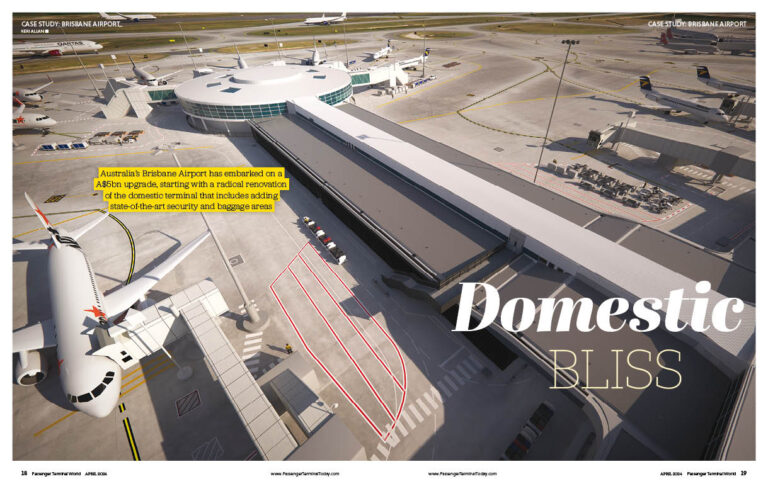Brisbane Airport (BNE) in Australia has begun the biggest transformation in its history. A$5bn (US$3.3bn) is being invested in the 10-year Future BNE program, which comprises more than 150 projects. These include upgrades to its domestic and international terminals, plus work on a third terminal set to open just before Brisbane hosts the Olympics in 2032.
Kicking things off is the domestic terminal precinct upgrade, which will support Queensland’s growing population and the rising number of passengers who will pass through its doors. Passenger numbers currently stand at 20 million a year and this is expected to grow by a further 10 million over the coming decade.
Let the work commence
After almost five years of planning, the project entered the delivery phase in September 2023 and aims to transform the 35-year-old terminal.
“This has come with some challenges,” notes Heidi Stone, senior project manager at Brisbane Airport Corporation. “We have a lot of aging infrastructure that’s end-of-life. So, as part of this project, and to support the new equipment we’re introducing, we need to upgrade a lot of that.”
“We have a lot of aging infrastructure that’s end-of-life” Heidi Stone, Brisbane Airport Corporation
“The domestic terminal opened just before World Expo ’88,” continues Gert-Jan de Graaff, Brisbane Airport Corporation’s CEO. “It’s a beautiful building but not so practical today. We’re touching almost every part of the terminal with this redevelopment. The interior will completely change; only the walls and ceiling will remain the same.”
The most significant structural alteration to the building is a new mezzanine level, but ultimately the project aims to transform the way the entire terminal looks, functions and operates.
In addition to the mezzanine, which will offer direct entry to security screening for checked-in passengers with carry-on luggage, the project also includes a new BHS (to find out more, read Passenger Terminal World‘s exclusive interview with Helder Lira, Alstef Group project director, Brisbane Airport here), security system and expanded self check-in and automated bag-drop points, plus upgrades to departure gate lounges, retail, food and beverage and bathrooms, as well as an extension to the multilevel parking garage.
This work will take place in stages over a two-year period, with public-facing works expected to ramp up as this year progresses.
Stage 1
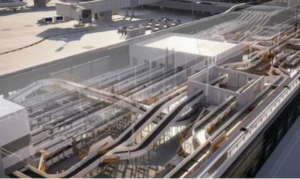
Airside works came first, which included enabling works for the new baggage system. This entailed building either side of the existing airside pier, moving a light pole and changing the airside road to create space for the new system.
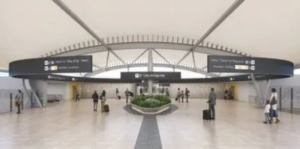
The domestic terminal project was sparked by the Australian government’s Strengthening Aviation Security Initiative, which has mandated the implementation of advanced security systems by December 2025 to provide passengers with a uniform security experience across all major airports in the country.
This will require the installation of new CT technology in Brisbane – a contract awarded to Rapiscan Systems – which will not only improve security screening but also provide a more streamlined process that will enable passengers to leave most items in their hand luggage, including aerosols and laptops.
The new equipment will be longer, bulkier and heavier than that currently in place at BNE, and won’t fit in the same location. This led to the idea of building a new mezzanine level specifically for the new equipment. This will also provide direct access to security screening from the Skywalk walkway – which connects the parking garage to the terminal – for passengers who have already checked in and are traveling with carry-on luggage only.
Passenger experience during works
The domestic terminal will continue to operate as usual during upgrade works, welcoming roughly 60,000 passengers each day. During certain stages, temporary security screening and check-in desks will be set up on the forecourt so that existing areas can be shut down for upgrade work.
Minimizing disruption is key to the project – hence the staged approach – but so is keeping passengers informed, both before and during their time at the airport.
“The impact on our passengers is going to be an ongoing need we’ll have to address, and we’re using our communication channels to ensure everyone is well informed of the situation before they arrive,” says Lauren Kelly, communications manager of major projects at Brisbane Airport Corporation.
BNE decided to be proactive and shared an animation in the summer of 2023 that shows how the changes will be accomplished and what form they will take. The project team believes this has been integral to getting people on board with the initiative.
“We’re also making sure we have clear communication channels in place on-site, from our ambassadors welcoming people into the terminal to our airline staff checking in passengers,” Kelly explains. “The staged approach will hopefully minimize disruptions, but working in a live environment there are always unknowns; things can happen we don’t expect, and this is why it’s important to have these different communication channels in place.”
Don’t worry, be happy
BNE’s philosophy for passengers is ‘don’t worry, be happy’, and improving the passenger experience is at the heart of the work taking place at the domestic terminal. This redevelopment aims to make passenger flow as seamless and intuitive as possible. “And then try to have a bit of fun, excitement and entertainment on top of that,” says de Graaff.
“We’ve brought the business lounge out to the people!” Gert-Jan de Graaff, Brisbane Airport Corporation
“We were very clear about what we expected from the project teams,” he continues. “They were designing the environment for people, not for machines or the aircraft. Passenger experience is front and center of everything we’re doing here.
“Through the changes and upgrades to security and check-in, the whole departure process will be enhanced. Then, once through security, they’ll be met by a new integrated retail and gate area. Gone are the boring black benches; we’ve brought the business lounge out to the people!”
For example, Stone highlights that BNE is changing the narrative with security screening to make it a much calmer, more enjoyable experience.
“We’ve also had a big focus on inclusive design, to ensure all passengers of all abilities are catered for, which has been really exciting,” she says.
“Examples include introducing carpets into the security screening area to reduce noise, which tends to help people who are neurodivergent stay calm, ensuring audio is turned on in elevators and introducing quiet rooms. We’re introducing a number of features along the passenger journey to make it more comfortable and enjoyable for everyone.”
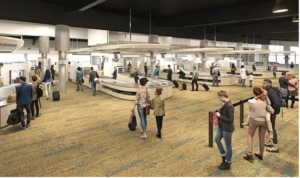
This project also gave the airport with an opportunity to showcase its home state of Queensland, and many of the interiors have been inspired by regional landscapes.
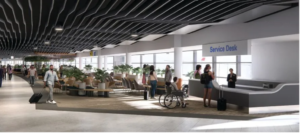
“We’ve opted for things like a custom carpet inspired by Queensland beaches, which has the texture and look of sand,” Stone says. “We’ve also sourced local hardwood timbers, including spotted gum. We’re hoping to have the essence of Queensland throughout.”
Sustainability
Another subject close to BNE’s heart is sustainability, and the airport aims to achieve net zero in 2025 for Scope 1 and Scope 2 emissions.
As part of her work, Stone looked at sourcing local materials where possible and those with recycled content or, at the very least, materials that can be recycled. The new carpets are made from recycled material and the new bench tops are made from 14-20% recycled material.
“I also looked at our waste strategy and how we manage recycled goods, and we’ve implemented a lot more recycling options in our new design to encourage that strategy,” she explains. “We looked at electric motors for our baggage handling systems and have a lot of additional projects happening as part of Future BNE that focus on sustainability.
“We’re trialling low-carbon asphalt and concrete, and specifically for the domestic terminal we’re deploying a large solar farm and rolling out electric infrastructure for all our ground equipment. Gone are the old diesel motors; all our specialist airfield equipment will plug and charge.”
“Brisbane has a subtropical climate with an abundance of sunshine, so solar power is really important to the airport,” adds de Graaff. “Around 30% of our power is generated through solar, and from 2025 our procurement of power will be 100% from solar and wind-generated sources.”
Balancing the construction work against BNE’s sustainability goals also provided a platform for Stone and her colleagues to find partners in the construction industry with a similar mindset, and who weren’t afraid to experiment with new ideas and drive change.
“We have some pretty ambitious targets with our contractors and have stringent waste strategies in place,” she says. “We’re tracking just how much waste we’re removing from the airport and have systems in place to ensure as much as possible will be recycled. This requires a lot more effort and coordination, but that’s how we’re managing the construction process.”
“Around 30% of our power is generated through solar” Gert-Jan de Graaff, Brisbane Airport Corporation
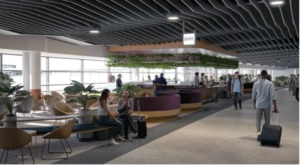
What’s next?
A comparable project for BNE’s international terminal will follow directly on from the domestic project. The security equipment will need to be upgraded and, as de Graaff puts it, “We have a similar issue shoehorning this into the original location so will be relocating the security checkpoint here too.”
Passport control and immigration will also be moved and the duty-free store will be expanded. “It’s a pretty significant redevelopment, especially for departing passengers,” says de Graaff.
“We’re also going to run out of capacity by 2030/2032, and so we’re in the process of planning for a new third terminal,” he continues. “We haven’t decided whether this will be domestic, international or a combination of both, or which airlines will go there yet. The only thing we know for sure is where we’re going to locate it, which is next to the domestic terminal, right between the two runways.
“We opened the second runway in 2020, which shifted the center point of the airport to that location and provides connectivity with the domestic terminal but will also enable us to create a whole new terminal precinct with minimal taxi times to the runway. This provides not only a good passenger experience but also benefits in terms of environmental sustainability.”
On top of this, BNE has 500ha of land available for commercial development, and is focusing on the development of its industrial precincts, its Aerotech Park and its center for aeromedicine. “The city, and Queensland more generally, is growing and this provides us with a unique opportunity to develop the airport further – in a way that’s based around sustainability and the passenger experience. We want to make sure that the people here in the community can be proud of what we’ve built,” de Graaff concludes.
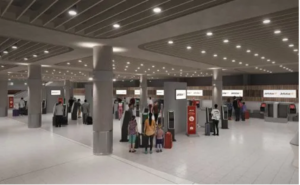
This article originally appeared in the April 2024 issue of Passenger Terminal World. To view the magazine in full, click here.


